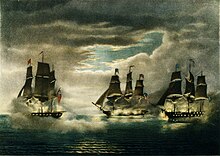HMS Levant (1813)
 Levant
| |
| History | |
|---|---|
| Name | HMS Levant |
| Ordered | 18 November 1812 |
| Builder | William Courtney, Chester |
| Laid down | January 1813 |
| Launched | 8 December 1813 |
| Completed | By 22 April 1814 |
| Fate | Broken up by 9 October 1820 |
| General characteristics | |
| Class and type | Rated 20-gun sixth rate |
| Tons burthen | 464 42⁄94 bm |
| Length |
|
| Beam | 29 ft 10 in (9.09 m) |
| Draught | 9 ft 6 in (2.90 m) |
| Depth of hold | 8 ft 6 in (2.59 m) |
| Complement | 135 |
| Armament | 2 x 6-pounders bow chasers + 20 x 32 pounder carronades |
HMS Levant was a 20-gun
Career

Levant was one of 16 ships of the Cyrus class that had the underwater lines of the French
While escorting two British convoys together with
A British squadron under
Fire from HMS Leander led Levant's crew to run her ashore, where HMS Acasta then captured her.[2][3] Collier eventually left Acasta and HMS Newcastle windward of Barbados while he searched for Constitution. However, she had returned to port, thus avoiding an engagement.[Note 1]
Because Portugal was unable to maintain its neutrality on its (former) soil the Portuguese government compensated the United States for the loss of Levant.
Captain John Sheridan commanded Levant from June 1815 until she was laid up in Chatham in November that year.
Fate
Levant was intended to be repaired and returned to service in August 1820, but this was not carried out and she was broken up by 9 October 1820. Her captured ensign was on display at Mahan Hall at the U.S. Naval Academy, but was removed on 27 February 2018 for preservation.[5]
Notes
Citations
- ^ A Naval Biographical Dictionary: Jones, Alexander. By William Richard O'Byrne. Published 1849. Accessed 2 Dec 2022.
- ^ Gossett (1986), p.95.
- ^ "No. 17010". The London Gazette. 9 May 1815. p. 871.
- ^ "No. 17200". The London Gazette. 14 December 1816. p. 2366.
- ^ "U.S. Naval Academy Museum". www.facebook.com. Retrieved 28 February 2018.
References
- Gossett, William Patrick (1986) The lost ships of the Royal Navy, 1793-1900. (London: Mansell). ISBN 0-7201-1816-6
- James, William (1837). The Naval History of Great Britain, from the Declaration of War by France in 1793, to the Accession of George IV. Vol. 6. R. Bentley.
- Martin, Tyrone G. (2003) A Most Fortunate Ship. A Narrative History Of Old Ironsides. Revised Edition.
- Winfield, Rif (2008). British Warships in the Age of Sail 1793–1817: Design, Construction, Careers and Fates. Seaforth. ISBN 978-1861762467.
External links
 Media related to HMS Levant (ship, 1813) at Wikimedia Commons
Media related to HMS Levant (ship, 1813) at Wikimedia Commons- USS Constitution Museum
- Age of Nelson
